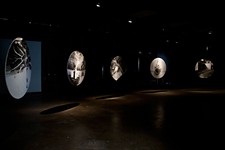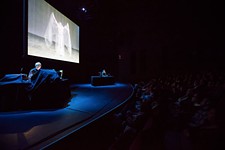CAMIBAart Gallery's Troy Campa
This local gallerist left behind a successful career in architecture to develop a new creative life in the art world
By Madeline Irvine, Fri., Nov. 18, 2016
If you could reinvent your life, what would it look like? What would you have to do to get from here to there? Many people play with the former question, but few follow through on the latter.
In 2013, Troy Campa did just that. Mid-career as an architect in Houston, with a successful business in high-end residential architecture and a staff of 15, Campa decided he was "ready for something new in life" and with his husband, Rene Ibarra, turned his skills toward finding it. The process took a few years, but eventually it led Campa and Ibarra to Austin.
The upshot is a new voice in our city's visual arts scene: CAMIBAart Gallery, located at the Flatbed Press complex and at CAMIBAart on Sixth. Campa shows a roster of Texas-based gallery artists who focus on materials-based work – which means that paintings won't necessarily look like a flurry of impressionistic brushstrokes. "We are looking for artists that are pushing or challenging their materials in unique ways, and therefore, most of the works are abstract. That is not a requirement; that is a result," Campa notes.
Ibarra, who co-founded the gallery (the "Iba" in CAMIBA), is an essential partner. "He is the ear," Campa explains. "He listens and gives feedback, so he is an important adviser for me."
Most galleries reflect their owners' aesthetics. In CAMIBA's first year, much of the work on display had a strong geometric quality. Campa thinks that is an outgrowth of his experience in architecture, in how things are built and put together: "But I also like it when you cannot tell what the structure is, when you cannot tell how it is put together at all."
Initially, the modernist aesthetic was a large influence for Campa. Yet nature in all its manifestations quickly became a constant subtext of the work on view at CAMIBA. Landscape is not the chosen form; more often, the artworks depict the unseen structures and forces that compose nature. Often treating paint as a sculptural material, a number of Charlotte Smith's works depict forces massing at the top of the work and dispersing as they fall down over the edge. Other artists, such as Orna Feinstein, play with our visual perceptions. Her images exist in both 2-D and 3-D worlds, slipping and sliding between dimensions as one moves around the artwork.
Getting Here From There
The arts have been a driving force in Campa's life since the age of 6 or 7. After seeing a Jackson Pollock show in Houston, Campa remembers "coming home to do it with model paint jars: throwing the paint and dabbing down the open tops to make circles." He also loved to draw floor plans as a kid, causing his great-grandmother to say, "You need to be an architect."
He became one. But as the business end of architecture came to overwhelm the creative, Campa was drawn to use the driving force of art to redirect his life. "I came to a point where I realized I was ready to do something new in life," he says. "It took about six months to transition me out of the business. Rene and I started evaluating where we wanted to go. It was more a result of soul-searching than a direct focus on 'This is what I am going to do.' I am a collector, so when I was soul-searching for what was next, I knew it would be in the arts."
Campa and Ibarra discussed many places, from Canada to Mexico and back to Texas, but Houston was always off the list. Campa feared he'd be too easily pulled back into architecture.
"There was something in me that knew that I wanted to be involved in the arts, and Austin had a lot of potential for growth in that area. There is a very established art community here. It is about establishing the connection between the collector and the artist," says Campa.
"In the front of my mind, I hadn't made any decisions. In the back of my mind, I had decided I wanted to work in the art community. We had been here a year, but it took me six months to plan the first pop-up exhibit. I was enjoying life, and that year was about taking time off and decompressing from the architecture firm. It was about giving me space." After his first pop-up show sold work the first night, Campa jumped headfirst into Austin's art world.
Finding a Place on the Scene
Campa's chosen field – commercial galleries – can be as much a labor of love as making art is. As elsewhere, there are flush times and lean times. Although Austin today has more commercial galleries than ever, its history has seen many a gallery open, glow bright for a few years or a decade, and then close up shop. Only a handful of local galleries – including Stephen L. Clark Gallery, Wally Workman Gallery, Davis Gallery, and Gallery Shoal Creek – have weathered the vagaries of the art and financial markets for decades. But now, across the country, the business is undergoing a transformation that's making it harder for midlevel galleries to survive, in large part because of the proliferation of art fairs.
Personality as well as aesthetics affect a gallery's trajectory. Campa's personable, upbeat presence and innate creativity give him the perfect tools for building a new model to survive in a reconfigured, 21st century commercial gallery world. Peruse CAMIBAart's website, and it is easy to see Campa's creativity at work. Diversification of events and education that aim to open up new directions for the public are key to the gallery's success. Each year, Campa conducts curated studio tours during EAST, and the gallery has a burgeoning art tour business, with Ibarra – a great people person – as director. (Future destinations include Havana, San Miguel de Allende, Budapest, and Mexico City.) New to the CAMIBAart mix is an out-of-town pop-up exhibition back in Campa's hometown of Houston.
Austin has turned out to be a good fit for Campa's reinvented life, and he's taking what he's learned here to make it even better: "Galleries are much more cooperative than I imagined. There is a definite, supportive community here. I get a lot of people who are from out of town, who have just moved here, who are looking for the art community. There are seeds, and things can grow from that. I look for what the positive aspects are and build on those."
Even without architecture, Campa remains a builder. Inclusive and supportive, he operates on many levels in the community – building bridges being one of his strengths. Managing a second gallery, CAMIBAart on Sixth (2000 E. Sixth), allows him to show new artists who share his artistic voice, as well as host group shows that highlight work by arts organizations such as the Texas Society of Sculptors and Art From the Streets, which shows there every year during EAST.
Does Campa miss architecture? "It's hard to give up building things, yes," he says. "I don't miss architecture. The whole business of architecture is not just the creative endeavor of building things or designing things, it was everything that went with that.
"CAMIBAart is my creative outlet. There is so much growth potential with the art community here. There is a growing market, and it is our job as gallerists and consultants to encourage and educate the growth. We can help people understand how they could positively impact the art community.
"And that is what I like art to do for people: to inspire them."
CAMIBAart at Flatbed (110) is showing “Edward Lane McCartney: Chromatic Fantasy.” 2382 E. MLK.
CAMIBAart on Sixth (418-419) is showing "1200 and Under: A Group Exhibit" and "Art From the Streets." 2000 E. Sixth.











